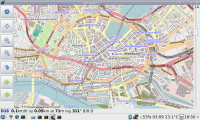Difference between revisions of "GPS"
(→Bluetooth GPS) |
|||
| Line 27: | Line 27: | ||
=== USB GPS === | === USB GPS === | ||
Someone with a USB GPS will need to fill in this section | Someone with a USB GPS will need to fill in this section | ||
| + | |||
| + | === Verify that you are receiving data === | ||
| + | You can check this by opening up the terminal and running (for example): | ||
| + | <pre> | ||
| + | cat /dev/rfcomm0 | ||
| + | </pre> | ||
== Software == | == Software == | ||
| Line 32: | Line 38: | ||
=== gpsd === | === gpsd === | ||
===== Installation ===== | ===== Installation ===== | ||
| − | Installing gpsd is a requirement for using many GPS related programs. It can be installed through opkg: | + | Installing gpsd is a requirement for using many GPS related programs. It can be installed through opkg, however the version currently in the Angstrom repos is too new for some applications (specifically tangoGPS). However if you want to install it this way you can by running: |
<pre>sudo opkg install gpsd</pre> | <pre>sudo opkg install gpsd</pre> | ||
| − | + | Now if you do want the older version which does work with tangoGPS, you must download it from [http://www.angstrom-distribution.org/feeds/2008/ipk/glibc/armv7a/base/gpsd_2.38-r0.1_armv7a.ipk here]. Put that file somewhere convenient, like the root of an SD card. You can still use opkg to install it, for example if you have it on the root of the right hand side SD card: | |
| − | + | <pre>sudo opkg install /media/mmcblk1p1/gpsd_2.38-r0.1_armv7a.ipk</pre> | |
=== TangoGPS === | === TangoGPS === | ||
[[Image:Tangogps.png|thumb|right|200px|tangoGPS running on a Pandora]] | [[Image:Tangogps.png|thumb|right|200px|tangoGPS running on a Pandora]] | ||
| + | Be aware that by default data for the maps are stored into your home directory (on the NAND if you're not [[Running_Linux_from_an_SD_card | running off an SD card]]). | ||
===== Installation ===== | ===== Installation ===== | ||
Until someone makes a PND, you can use opkg: | Until someone makes a PND, you can use opkg: | ||
<pre>sudo opkg install tangogps</pre> | <pre>sudo opkg install tangogps</pre> | ||
| + | |||
| + | You should now find TangoGPS in the "other" category of the menu. | ||
[[Category:Documentation]] | [[Category:Documentation]] | ||
[[Category:Tutorials]] | [[Category:Tutorials]] | ||
Revision as of 00:15, 27 July 2010
Contents
Setting up your GPS
Bluetooth GPS
First, turn on Bluetooth on your Pandora. Now, open up terminal and do:
hcitool scan
This scans for bluetooth devices. Find your GPS device on the list and make a note of it's MAC address (it is in the form xx:xx:xx:xx:xx:xx).
Now you want to find the channel for your bluetooth GPS, run the command (replacing the example MAC address with your own):
sdptool browse xx:xx:xx:xx:xx:xx
Now you need to edit /etc/bluetooth/rfcomm.conf. In this example I use nano, but you can use whatever editor you like. Do:
sudo nano /etc/bluetooth/rfcomm.conf
Fill in rfcomm.conf using the following template and the information you found using the steps listed above:
rfcomm0 {
bind no;
device xx:xx:xx:xx:xx:xx;
channel 1;
comment “GPS”;
}
Now connecting to your GPS is as simple as running the command:
sudo rfcomm connect 0
USB GPS
Someone with a USB GPS will need to fill in this section
Verify that you are receiving data
You can check this by opening up the terminal and running (for example):
cat /dev/rfcomm0
Software
gpsd
Installation
Installing gpsd is a requirement for using many GPS related programs. It can be installed through opkg, however the version currently in the Angstrom repos is too new for some applications (specifically tangoGPS). However if you want to install it this way you can by running:
sudo opkg install gpsd
Now if you do want the older version which does work with tangoGPS, you must download it from here. Put that file somewhere convenient, like the root of an SD card. You can still use opkg to install it, for example if you have it on the root of the right hand side SD card:
sudo opkg install /media/mmcblk1p1/gpsd_2.38-r0.1_armv7a.ipk
TangoGPS
Be aware that by default data for the maps are stored into your home directory (on the NAND if you're not running off an SD card).
Installation
Until someone makes a PND, you can use opkg:
sudo opkg install tangogps
You should now find TangoGPS in the "other" category of the menu.
